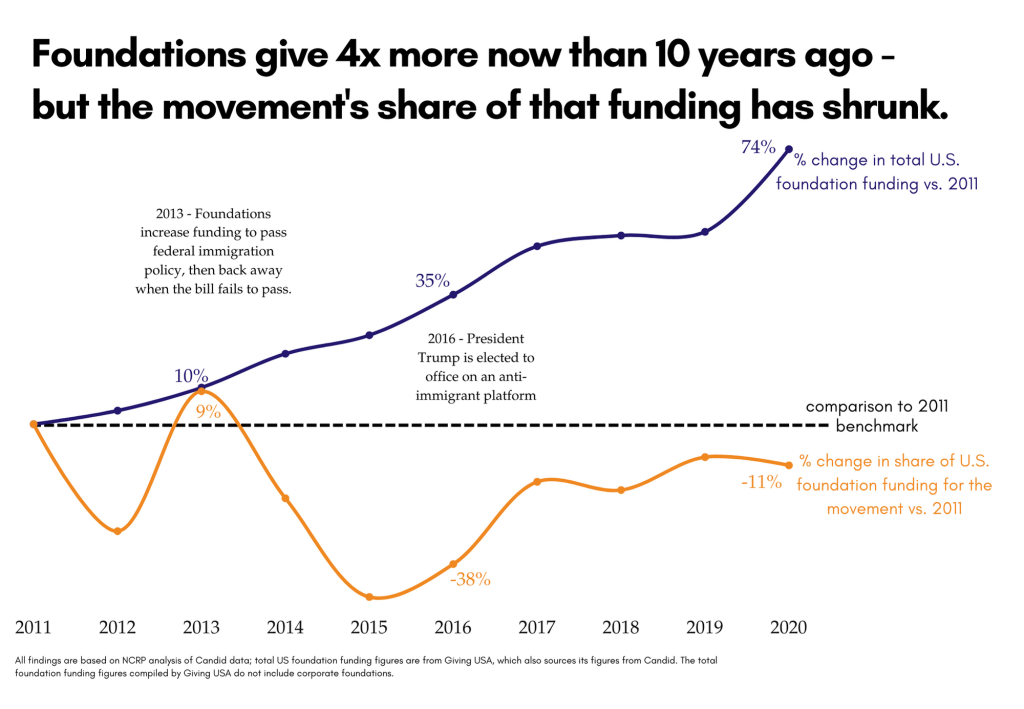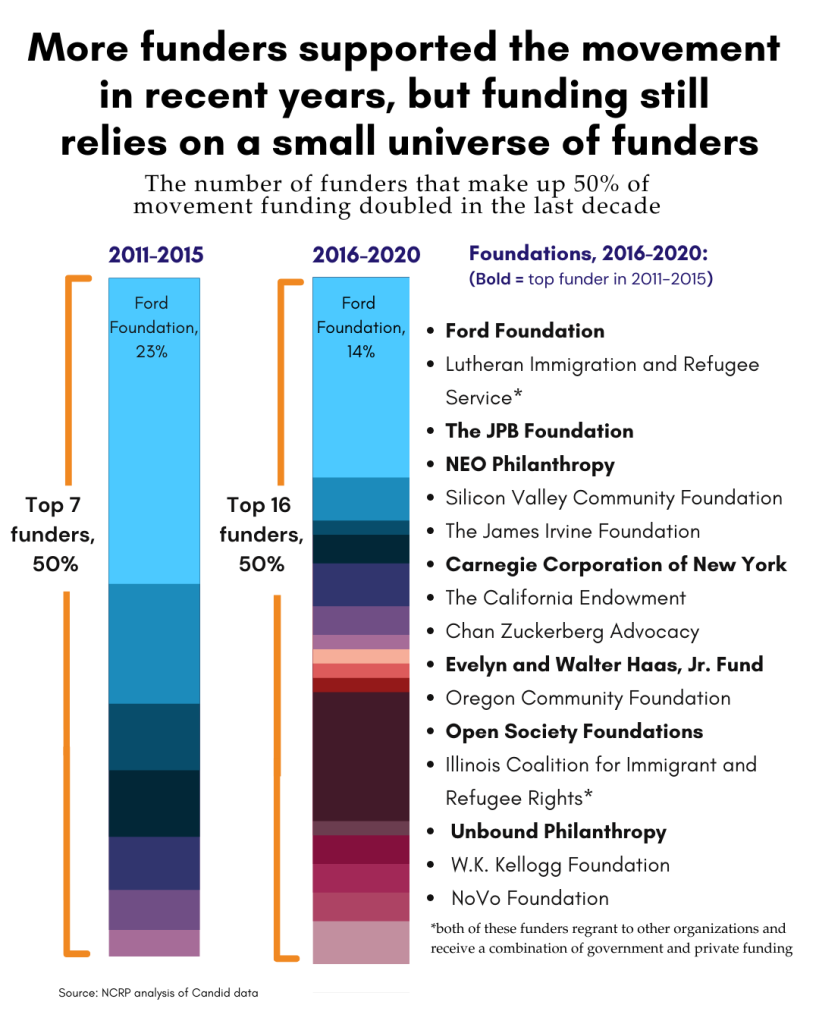Methodology
The most recent available data for this analysis ends in 2020. At NCRP, we know that a lot has happened in the years since and that philanthropy has shifted in ways both good and bad, which can’t be reflected in this data. However, based on what we hear from frontline groups on the ground and folks in the philanthropic sector, we believe the broader trends we name here remain true today.
DEFINITIONS [1]
Local funding refers to funding from foundations to recipient organizations located in and serving the population of the same state or region (e.g., an Alabama-based funder giving to an Alabama-based organization).
Population funding refers to grants that explicitly benefit immigrants, refugees, and asylum seekers in the United States.
Per capita funding refers to foundation grant dollars given per immigrant living in the region. Immigrant community figures are sourced from 2020 American Community Survey data filtered for each state, using the “foreign-born population” numbers. Because immigrants are chronically undercounted in the census, the per capita figures shared in this analysis are likely an overcount.
Pro-immigrant and pro-refugee movement groups refer to organizations dedicated to building power and honoring the civil and human rights of immigrants and refugees in the United States. Organizational activities include but are not limited to state-based advocacy campaigns, civic engagement, community organizing and grassroots leadership development. For more information on movement groups and the pro-immigrant movement, read NCRP’s 2019 brief, the State of Foundation Funding for the Pro-Immigrant Movement.
MOVEMENT FUNDING DATA [2]
Grantmaking data
NCRP derived foundation grantmaking figures for the pro-immigrant and pro-refugee movement by analyzing Candid data, beginning with grants under Candid’s “immigrant rights” subject code and adding all grants to over 150 known pro-immigrant organizations to create a broad dataset of pro-immigrant and pro-refugee grants. There is no “pro-immigrant movement” checkbox on the Form 990, nor is there a pro-immigrant movement code in Candid, so it is likely that some grants were left out of the data, but this is our best approximation of grant data for the ecosystem of organizations in the movement.
The dataset reflects grantmaking data from 2011-2020 to include a broad view of grantmaking for the pro-immigrant and pro-refugee movement over the last decade. Grantmaking data from 2020 is not complete because data are still being collected by Candid, but we are confident that the available data are representative of total funding for the year.
In addition, because of changes to Candid’s data collection for its database, grantmaking figures prior to 2014 capture a relatively smaller slice of total foundation funding than Candid grantmaking figures post-2014. Beginning in data year 2015, the scope of Candid’s tracking of grantmaking data expands, increasing the total number of grants available in Candid’s database. Because of this change, it is difficult to separate with 100% certainty the increase in funding for the pro-immigrant and refugee movement over these years from the growing size of the sector and the growing slice of the sector tracked in Candid’s systems, especially for grants data prior to 2015.
In NCRP’s analysis, the 2015 scope change is most noticeable for two categories of grantmakers: public charities and community foundations. After 2015, the number of public charities and community foundations included in the dataset giving to the pro-immigrant and refugee movement per year was consistently higher than 2014 and prior. For example, the number of public charities in our dataset increased six-fold from 33 in 2014 to 182 in 2015, and the number of community foundations increased from 44 in 2014 to 77 in 2015. It is important to note that this increase in the number of grantmakers was not significant for independent foundations and family foundations during this time, which make up the majority of funding for the movement across all years of data.
NCRP’s analysis includes percentages of totals to provide a perspective on the changing sector that is not affected by the always-growing scope of Candid’s data collection.
Coding Funds and Movement Roles
NCRP researchers coded grant recipients based on a list of qualitative characteristics: Whether the organization provides direct services, whether the organization is a network, the geographic scope of the organization’s work, and the primary and secondary movement roles performed by the organization.
Movement roles were determined based on NCRP’s interpretation and application of the Ayni Institute’s movement ecology framework, which can be found in the 2018 report Funding Social Movements, by Paul Engler, Sophie Lasoff and Carlos Saavedra.
Funding data for the movement does not include:
• Intermediaries as recipients of funding. Intermediary grantmakers (e.g., Borealis, New Venture Fund) receive funding from other foundations to regrant to movement organizations – their data as a recipient of funds from foundations was removed from the analysis, and only their grantmaking data are included.
• College scholarship grants: In some cases, grants for college scholarships, or scholarships specifically for DACA recipients, were coded as “immigrant rights” in Candid. While these grants are considered as benefitting immigrant and refugee populations, we did not include them as power-building grants for the pro-immigrant and pro-refugee movement, so these grants are excluded from the analysis.
• COVID-19/Coronavirus pandemic relief grants: Grants data were excluded from movement funding data if: 1) the recipient organization does not primarily focus on immigrants or power-building for immigrant rights and 2) the grant itself did not focus on immigrants or have a power-building element to it (e.g., a grant description that only says “COVID-19 emergency response,” “coronavirus relief,’ or “cash assistance to individuals affected by COVID-19″). COVID-19 related grants were kept in the dataset, even if the recipient was not primarily an immigrant-serving organization or power-building organizing group, if the grant was intended specifically for immigrants and refugees based on the grant description or there was a power-building aspect to the grant (e.g., “For operating support for meeting critical COVID-19 related needs, “emergency response grants for programs and services to meet crucial needs.”)
• Philanthropic funding in Puerto Rico, the U.S. Virgin Islands and other U.S. territories: Candid data for these regions is unfortunately limited. The territories’ legal status also contributes to some confusion when it comes to how foundations describe funding for local immigrant populations. For these reasons, they have been excluded from this analysis.
STATES INCLUDED IN EACH REGIONAL BREAKDOWN
| Midwest | Pacific Northwest | Mountain West | Northeast | South | Southwest |
Iowa
| Oregon
| Colorado
| Connecticut
| Alabama
| Arizona |
| Illinois | Washington | Idaho | Delaware | Arkansas | New Mexico |
| Indiana | | Montana | District of Columbia | Florida | Texas |
| Kansas | | Nevada
| Massachusetts | Georgia | |
| Michigan | | Utah | Maryland | Kentucky | |
| Minnesota | | Wyoming | Maine | Louisiana | |
| Missouri | | | New Hampshire | Mississippi | |
| North Dakota | | | New Jersey | North Carolina | |
| Nebraska | | | Pennsylvania | Oklahoma | |
| Ohio | | | Rhode Island | Oklahoma | |
| South Dakota | | | Vermont | South Carolina | |
| Wisconsin | | | | Tennessee | |
| | | | Virginia | |
| | | | West Virginia | |
| | | | | |
Alaska and Hawaii are not included in specific regional analyses, but data for these two states is included in the national data analysis. Data specific to Alaska and Hawaii is also included in the Appendix.
The grantmaking data for California and New York are only included as state-level data instead of including them as part of regional data. The concentration of foundations and nonprofits located in both states means that the grantmaking totals for each state would skew the regional analyses, so data for New York and California are treated as their own “regions.”
Additional state-by-state analysis is available in the Appendix.
FUNDING FOR UNDERFUNDED COMMUNITIES
We also examined foundation funding to pro-immigrant and pro-refugee movement groups that focus primarily on underfunded communities even within the immigrant diaspora. For this additional analysis, we examined grant data for 501c3 groups whose primary focus was Black migrant communities, AAPI migrant communities, LGBTQ migrant communities, indigenous migrant communities, and refugees.
The organizations for each respective underfunded communities whose grants were included were identified through 1) self-identification in organizations’ public statements, name, and mission and 2) external review from movement leaders.
The underfunded communities that are highlighted in this research are not mutually exclusive communities, and the data are also not mutually exclusive.
ENDNOTES
1 As defined originally in the methodology for our 2020 interactive dashboard
2 First paragraph adapted from the definitions found in the 2019 State of Foundation Funding infographic methodology


